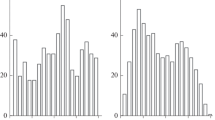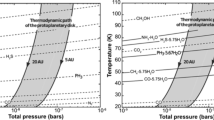Abstract
A previous study showed that a fingerprint of the initial shape of synthetic Oort clouds was detectable in the flux of “new” long-period comets. The present study aims to explain in detail how such a fingerprint is propagated by different classes of observable comets to improve the detection of fingerprints. It appears that three main long-term behaviors of observable comets are involved in this propagation: (1) comets that remain frozen during the entire time span and become observable only because of an increase in their orbital energy at the very end of their propagation; (2) comets whose perihelion distance performs an almost complete galactic cycle, while their galactic longitude of the ascending node and cosine of the galactic inclination remain almost constant; (3) comets whose perihelion distance and cosine of the galactic inclination perform a full galactic cycle, while their galactic longitude of the ascending node performs a half a cycle. This investigation allowed us to define four different zones for the previous perihelion distance, in which one or two of the above long-term behaviors dominate. Considering the distribution of the cosine of the ecliptic inclination and the galactic longitude of the ascending node at the previous perihelion distance, for the different zones, several fingerprints of the initial disk shape were highlighted. Such fingerprints appeared to be quite robust since they were still present considering the reconstructed orbital elements, i.e., the elements obtained from the original orbit after a backward propagation over one orbital period considering only the galactic tides.






Similar content being viewed by others
References
Brasser, R., Morbidelli, A.: Oort cloud and Scattered Disc formation during a late dynamical instability in the Solar System. Icarus 225, 40–49 (2013). https://doi.org/10.1016/j.icarus.2013.03.012
Brasser, R., Duncan, M.J., Levison, H.F.: Embedded star clusters and the formation of the Oort cloud. Icarus 184, 59–82 (2006). https://doi.org/10.1016/j.icarus.2006.04.010
Brasser, R., Duncan, M.J., Levison, H.F.: Embedded star clusters and the formation of the Oort cloud. II. The effect of the primordial solar nebula. Icarus 191(2), 413–433 (2007). https://doi.org/10.1016/j.icarus.2007.05.003
Brasser, R., Duncan, M.J., Levison, H.F.: Embedded star clusters and the formation of the Oort cloud. III. Evolution of the inner cloud during the Galactic phase. Icarus 196(1), 274–284 (2008). https://doi.org/10.1016/j.icarus.2008.02.016
Breiter, S., Ratajczak, R.: Vectorial elements for the Galactic disc tide effects in commentary motion. MNRAS 364(4), 1222–1228 (2005). https://doi.org/10.1111/j.1365-2966.2005.09658.x
Delsemme, A.H.: Galactic tides affect the Oort cloud: an observational confirmation. AAP 187, 913–918 (1987)
Dones, L., Weissman, P.R., Levison, H.F., Duncan, M.J.: Oort cloud formation and dynamics, ed. by M.C. Festou, H.U. Keller, H.A. Weaver 2004, p. 153
Duncan, M., Quinn, T., Tremaine, S.: The formation and extent of the solar system comet cloud. AJ 94, 1330–1338 (1987). https://doi.org/10.1086/114571
Dybczyński, P.A., Królikowska, M.: Where do long-period comets come from? Moving through the Jupiter–Saturn barrier. MNRAS 416, 51–69 (2011). https://doi.org/10.1111/j.1365-2966.2011.19005.x
Emel’yanenko, V.V., Asher, D.J., Bailey, M.E.: The fundamental role of the Oort cloud in determining the flux of comets through the planetary system. MNRAS 381, 779–789 (2007). https://doi.org/10.1111/j.1365-2966.2007.12269.x
Emel’yanenko, V.V., Asher, D.J., Bailey, M.E.: A model for the common origin of Jupiter family and Halley type comets. Earth Moon Planets 110, 105–130 (2013). https://doi.org/10.1007/s11038-012-9413-z
Fernández, J.A.: The formation of the Oort cloud and the primitive Galactic environment. Icarus 129(1), 106–119 (1997). https://doi.org/10.1006/icar.1997.5754
Fernández, J.A.: Evolution of comet orbits under the perturbing influence of the giant planets and nearby stars. Icarus 42, 406–421 (1980). https://doi.org/10.1016/0019-1035(80)90104-9
Fernández, J.A.: New and evolved comets in the solar system. AAP 96(1–2), 26–35 (1981)
Fernández, J.A., Ip, W.-H.: Dynamical evolution of a commentary swarm in the outer planetary region. Icarus 47, 470–479 (1981). https://doi.org/10.1016/0019-1035(81)90195-0
Fernández, J.A., Brunini, A.: The buildup of a tightly bound comet cloud around an early Sun immersed in a dense Galactic environment: numerical experiments. Icarus 145, 580–590 (2000). https://doi.org/10.1006/icar.2000.6348
Fouchard, M., Froeschlé, C., Rickman, H., Valsecchi, G.B.: The key role of massive stars in Oort cloud comet dynamics. Icarus 214, 334–347 (2011). https://doi.org/10.1016/j.icarus.2011.04.012
Fouchard, M., Rickman, H., Froeschlé, C., Valsecchi, G.B.: Planetary perturbations for Oort cloud comets. I. Distributions and dynamics. Icarus 222, 20–31 (2013). https://doi.org/10.1016/j.icarus.2012.10.027
Fouchard, M., Rickman, H., Froeschlé, C., Valsecchi, G.B.: On the present shape of the Oort cloud and the flux of; new; comets. Icarus 292, 218–233 (2017). https://doi.org/10.1016/j.icarus.2017.01.013
Fouchard, M., Froeschlé, C., Breiter, S., Ratajczak, R., Valsecchi, G.B., Rickman, H.: Methods for the study of the dynamics of the Oort cloud Comets II: modelling the Galactic tide, ed. by D. Benest, C. Froeschle, E. Lega, vol. 729, p. 273 (2007). https://doi.org/10.1007/978-3-540-72984-6_10
Fouchard, M., Higuchi, A., Ito, T., Maquet, L.: The “memory” of the Oort cloud. AAP 620, 45 (2018). https://doi.org/10.1051/0004-6361/201833435
Heisler, J., Tremaine, S.: The influence of the Galactic tidal field on the Oort comet cloud. Icarus 65(1), 13–26 (1986). https://doi.org/10.1016/0019-1035(86)90060-6
Higuchi, A., Kokubo, E.: Effect of stellar encounters on comet cloud formation. AJ 150, 26 (2015). https://doi.org/10.1088/0004-6256/150/1/26
Higuchi, A., Kokubo, E., Kinoshita, H., Mukai, T.: Orbital evolution of planetesimals due to the Galactic tide: formation of the comet cloud. AJ 134, 1693–1706 (2007). https://doi.org/10.1086/521815
Hills, J.G.: Comet showers and the steady-state infall of comets from the Oort cloud. AJ 86, 1730–1740 (1981). https://doi.org/10.1086/113058
Kaib, N.A., Quinn, T.: The formation of the Oort cloud in open cluster environments. Icarus 197(1), 221–238 (2008). https://doi.org/10.1016/j.icarus.2008.03.020
Kaib, N.A., Quinn, T.: Reassessing the source of long-period comets. Science 325, 1234 (2009). https://doi.org/10.1126/science.1172676
Leinert, C., Bowyer, S., Haikala, L.K., Hanner, M.S., Hauser, M.G., Levasseur-Regourd, A.-C., et al.: The 1997 reference of diffuse night sky brightness. AAPS 127, 1–99 (1998). https://doi.org/10.1051/aas:1998105
Matese, J.J., Whitman, P.G.: A model of the Galactic tidal interaction with the Oort comet cloud. Celest. Mech. Dyn. Astron. 54(1–3), 13–35 (1992). https://doi.org/10.1007/BF00049541
Nesvorný, D., Vokrouhlický, D., Dones, L., Levison, H.F., Kaib, N., Morbidelli, A.: Origin and evolution of short-period comets. APJ 845, 27 (2017). https://doi.org/10.3847/1538-4357/aa7cf6
Nordlander, T., Rickman, H., Gustafsson, B.: The destruction of an Oort Cloud in a rich stellar cluster. AAP 603, 112 (2017). https://doi.org/10.1051/0004-6361/201630342
Oort, J.H.: The structure of the cloud of comets surrounding the Solar System and a hypothesis concerning its origin. Bull. Astron. Inst. Neth. 11, 91–110 (1950)
Öpik, E.: Note on stellar perturbations of nearby parabolic orbit. Proc. Am. Acad. Arts Sci. 67, 1659–1683 (1932)
Rickman, H., Fouchard, M., Froeschlé, C., Valsecchi, G.B.: Injection of Oort Cloud comets: the fundamental role of stellar perturbations. Celest. Mech. Dyn. Astron. 102, 111–132 (2008). https://doi.org/10.1007/s10569-008-9140-y
Tsiganis, K., Gomes, R., Morbidelli, A., Levison, H.F.: Origin of the orbital architecture of the giant planets of the Solar System. Nature 435, 459–461 (2005). https://doi.org/10.1038/nature03539
Vokrouhlický, D., Nesvorný, D., Dones, L.: Origin and evolution of long-period comets. AJ 157(5), 181 (2019). https://doi.org/10.3847/1538-3881/ab13aa
Whipple, F.L.: On the distribution of sernimajor axes among comet orbits. AJ 67, 1–9 (1962). https://doi.org/10.1086/108596
Wiegert, P., Tremaine, S.: The evolution of long-period comets. Icarus 137(1), 84–121 (1999). https://doi.org/10.1006/icar.1998.6040
Acknowledgements
The authors are grateful to both referees, Luke Dones and Julio A. Fernández for helpful comments. We would like to thank Editage (www.editage.com) for English language editing. This work was supported by the Programme National de Planétologie (PNP) of CNRS/INSU, co-funded by CNES.
Author information
Authors and Affiliations
Corresponding author
Additional information
Publisher's Note
Springer Nature remains neutral with regard to jurisdictional claims in published maps and institutional affiliations.
This article is part of the topical collection on Trans-Neptunian Objects Guest Editors: David Nesvorny and Alessandra Celletti.
Appendices
A Forbidden region
The ecliptic coordinates of the Galactic pole in the North Hemisphere are \(l=180.02^\circ \) and \(b=29.81^\circ \); i.e., the galactic plane is inclined by \(\eta = 60.19^\circ \) with respect to the ecliptic plane. The origin of the galactic longitude \(\varGamma \) is located toward the present galactic center, with ecliptic coordinates of \(l=266.84^\circ \) and \(b=-5.54^\circ \). Calling A the ascending node of the ecliptic with respect to the galactic plane, the galactic longitude of A is, thus, \(L_\mathrm{{A}}=186.38^\circ \). Consequently, an object with an ecliptic inclination close to \(0^\circ \) would have its galactic longitude of the ascending node close to \(L_\mathrm{{A}}=186.38^\circ \). Similarly, an object with an ecliptic inclination near \(180^\circ \) will have its galactic longitude of the ascending node near \(6.38^\circ \) (see Leinert et al. 1998, for more details on the transformations between ecliptic and galactic coordinate systems). More generally, given an ecliptic inclination, not all values of the galactic longitude of the ascending node are allowed.
Considering A as the origin for the ecliptic and galactic longitude, we note \({\tilde{\Omega }}_\mathrm{{E}}\) and \({\tilde{\Omega }}_\mathrm{{G}}\) as the ecliptic and galactic longitude, respectively. Using spherical trigonometry, one can show the following:
If \(|\tan i_\mathrm{{E}}| > \tan \eta \), then \(\tan {\tilde{\Omega }}_\mathrm{{G}} \rightarrow \pm \infty \) as soon as \(\cos \tilde{\Omega _\mathrm{{E}}} \rightarrow -\frac{\tan \eta }{\tan i_\mathrm{{E}}}\). Noting that for \(x \rightarrow 0\), \(\sin x \sim x\), and \(\cos x -1 \sim -x^2/2\), this is also true for \(|\tan i_\mathrm{{E}}| = \tan \eta \) (similarly in \(\pi \)). Consequently, when \(i_\mathrm{{E}}\in [\eta , \pi -\eta ]\), \({\tilde{\Omega }}_\mathrm{{G}}\), and thus, \(\Omega _\mathrm{{G}}\) can take any value. If \(|\tan i_\mathrm{{E}}| < \tan \eta \), then \(\tan {\tilde{\Omega }}_\mathrm{{G}}\) is a bound smooth function of \({\tilde{\Omega }}_\mathrm{{E}}\). Differentiating Eq. 1 with respect to \({\tilde{\Omega }}_\mathrm{{E}}\), one finds that extrema are obtained when
The extreme values of \({\tilde{\Omega }}_\mathrm{{G}}\) are then the solutions of
Let us call \({\tilde{\Omega }}_{\mathrm{{E}}1}\) the solution such that \({\tilde{\Omega }}_{\mathrm{{E}}1} \in [0,\pi /2[\).
As shown in Fig. 7(left), one notes that when \(0\le i < \eta \), when \({\tilde{\Omega }}_\mathrm{{E}}=0\) or \(\pi \), \({\tilde{\Omega }}_\mathrm{{G}}=0\). Consequently, the range of values spanned by \({\tilde{\Omega }}_\mathrm{{G}}\) is \([-{\tilde{\Omega }}_{\mathrm{{E}}1},{\tilde{\Omega }}_{\mathrm{{E}}1}]\). Further, because \(\Omega _\mathrm{{G}}={\tilde{\Omega }}_\mathrm{{G}}+L_\mathrm{{A}}\), the range for \(\Omega _\mathrm{{G}}\) is \([L_\mathrm{{A}}-{\tilde{\Omega }}_{\mathrm{{E}}1},L_\mathrm{{A}}+{\tilde{\Omega }}_{\mathrm{{E}}1}]\).
Similarly, when \(\pi -\eta \le i < \pi \), as shown in Fig. 7(right), one notes that if \({\tilde{\Omega }}_\mathrm{{E}}=0^\circ \) or \(\pi \), then \({\tilde{\Omega }}_\mathrm{{G}}=\pi \). Thus, the range of values spanned by \({\tilde{\Omega }}_\mathrm{{G}}\) is \([\pi -{\tilde{\Omega }}_{\mathrm{{E}}1},\pi +{\tilde{\Omega }}_{\mathrm{{E}}1}]\), and the range for \(\Omega _\mathrm{{G}}\) is \([\pi +L_\mathrm{{A}}-{\tilde{\Omega }}_{\mathrm{{E}}1},\pi +L_\mathrm{{A}}+{\tilde{\Omega }}_{\mathrm{{E}}1}]\).
In Fig. 4, the gray areas correspond to the forbidden regions for \(\Omega _\mathrm{{G}}\).
When \(0 \le i_\mathrm{{E}} \le \eta \), one can compute the extreme value of \(i_\mathrm{{E}}\) as a function of \({\tilde{\Omega }}_\mathrm{{G}}=\Omega _\mathrm{{G}}-L_\mathrm{{G}}\). We obtain
B Line \(i_\mathrm{{G}}=90^\circ \)
When we consider the orbital elements of an observable comet at the perihelion preceding the passage where the comet is observable, it means that we are considering a specific time at which the strength of the action of the Galactic tides is particularly strong because the perihelion distance is quickly decreasing toward the observable region.
It is well known from Heisler and Tremaine (1986) and Matese and Whitman (1992) that the strength of the Galactic tides increases with \(\sin i_\mathrm{{G}}\), where \(i_\mathrm{{G}}\) is the Galactic inclination. Consequently, our observable comets should have a preference for \(\sin i_\mathrm{{G}} \) close to one.
One can easily find, using spherical trigonometry, that \(i_\mathrm{{G}}=90^\circ \) implies that:
Rights and permissions
About this article
Cite this article
Fouchard, M., Emel’yanenko, V. & Higuchi, A. Long-period comets as a tracer of the Oort cloud structure. Celest Mech Dyn Astr 132, 43 (2020). https://doi.org/10.1007/s10569-020-09978-0
Received:
Revised:
Accepted:
Published:
DOI: https://doi.org/10.1007/s10569-020-09978-0





